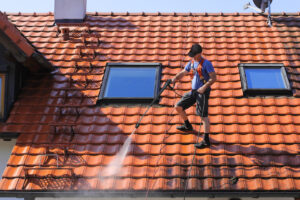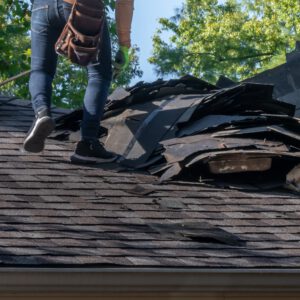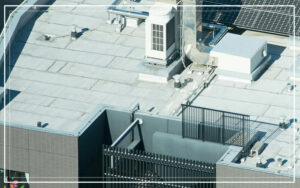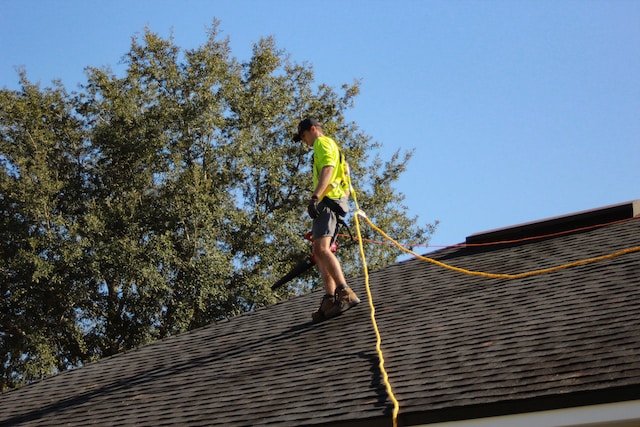If your shingles appear dark and discolored, especially in the north and west-facing areas, this is likely due to colonies of algae or moss. Keeping your roof clean will keep these moisture-loving organisms at bay.
Regular roof cleaning in Roof Cleaning MT Pleasant can help protect your home and increase its resale value. It can also prevent fungus and moss from damaging the shingles and voiding the warranty.

The roof of a home is an important investment that protects the interior from weather and pests, so it needs to be kept in good condition. Preventative maintenance, such as cleaning and inspections, can prolong its lifespan and avoid expensive repairs in the future. One of the most important tasks that need to be done regularly is debris removal. Debris can damage the surface of a roof, causing shingle loss and leaks. It can also settle into the gutter system, causing clogs and damaging the surrounding landscape. It is, therefore, vital to remove any leaves, twigs, tree branches, seeds, or other solid debris that may be wedged under and around roofing tiles.
The simplest and cheapest method of clearing debris from a roof is using a blower. This is best done on a dry day and only takes an hour or two. This only removes the surface of a roof, though, and won’t eliminate moss, mold, or stains. It is best used as a preliminary step before a deeper clean.
A more thorough option is a chemical wash, which uses antifungal and anti-algae cleaners to kill off any living organisms growing on the roof’s surface. These chemicals are applied to the roof with low water pressure, which is safe for most roofing materials. This is also the best way to get rid of lichen and moss, as they cannot be killed by regular water pressure.
Another benefit of regular roof cleaning is that it reveals areas of damage that might be hiding under layers of dirt and grime. Soft spots on the surface of a roof indicate the need for structural repair, which can then be promptly addressed to prevent further problems.
A well-maintained roof looks attractive and increases the overall curb appeal of a property, which can increase its value in the real estate market. It can also improve a property’s energy efficiency by ensuring that the roof is free from moss, algae, and lichen growth, which prevents proper ventilation and insulation. Moss and algae spores can also enter the house through ventilation systems, windows, and doors, which can cause respiratory issues and allergic reactions.
Moss and Algae Removal
The shaded areas of your roof can be a prime spot for moss and algae growth. It is not only unsightly, but it can reduce the value of your home. Leaving moss and algae unattended can damage the shingles or other roofing material, requiring costly repair or replacement. Moss and algae also harbor mold spores, which can affect your health.
A professional roof cleaning service can remove moss and algae build-up with a soft washing or a pressure wash, depending on the type of roof you have. A roof cleaner can also apply a moss-resistant product to the surface of your roof after the cleaning process is complete. While this does not exclude new moss formation, it will severely restrict it, extending the life of your roof.
Algae and moss growth results from some factors, including the amount of rainfall, the number of trees near your house, the type of tree, and the amount of shade your roof gets. Keeping your trees pruned and cleaning your gutters can help prevent the development of moss and algae in the future.
Using a safe, gentle outdoor cleaner that is compatible with your roof, such as Wet & Forget, can eliminate the fungus from the surface of your roof without damaging it. The cleaner is applied and allowed to dwell on the moss for 20 minutes, after which it is rinsed thoroughly with clean water.
The moss growth is also caused by the fact that it absorbs and retains moisture, which can cause it to become wet and saturated. As a result, it can lift the edges of shingles and make them more susceptible to shingle blow-off in windy weather.
Having your roof professionally cleaned can help eliminate moss, algae, and lichens. This will not only extend the life of your shingles, but it will improve the appearance of your home and add to its curb appeal. Having a dirty, dark green roof can lower the resale value of your house, so be sure to have it regularly cleaned to keep up with its appearance and health.
Increased Home Value
The roof is one of the most important parts of your home. It protects everything and everyone inside the house, keeping it safe and comfortable. The only way to get the most out of your roof is by having regular cleaning done. This will help you avoid costly replacements, and it will extend the life of your shingles. It will also keep the warranty intact, saving even more money in the long run.
Dirty and algae-filled roofs look less appealing to potential buyers and will detract from the overall value of your home. On the other hand, a clean, bright, and healthy-looking roof will add significant value to your home.
Another reason to have a regularly scheduled roof cleaning is that it will reduce the energy you need to cool your home during the summer months. The dark stains that form on the shingles absorb the sun’s heat and then transfer it into your home. A regular roof cleaning with a powerful chemical solution will reduce these stains and prevent them from increasing your energy bills during the hot Michigan summers. This will, in turn, decrease your carbon footprint and help you protect the environment.
Safety
While DIY roof cleaning is a popular way to save money, it poses risks of injury and property damage. Many homeowners fall off of ladders or roofs while attempting to clean their homes, and even professional cleaners often use equipment that can cause damage to tiles, shingles, and other roofing materials. Professional cleaners can safely and quickly remove moss, algae, mold, mildew, dirt, dust, debris, bird droppings, twigs, and other organic matter from roofs.
In addition to causing cosmetic damage, moss and other organic growths can cause serious structural problems for a home. Moss can lift shingles and create holes in the roof, while algae, fungus, and other organic material can rot or crack tile. A thorough and regular roof cleaning can prevent this degradation, extend the life of a roof, and protect the home’s foundation.
A dirty roof can also affect energy efficiency. Stains on a roof can cause the surface to absorb more heat from the sun, increasing air conditioning costs and shortening shingle life. A thorough, non-pressure roof washing can eliminate these stains and reduce energy costs.
Many roof warranties require proper maintenance, including regular cleaning. Refrain from cleaning your roof to avoid these warranties, which can lead to costly repairs and replacements. A thorough, non-pressure cleaning by a qualified professional can protect the warranty on your roofing materials and help you avoid expensive repair bills.
Mildew, mold, and mildew that accumulate on a roof can release spores into the air, posing health risks for your family. Cleaning your roof regularly can keep these spores from entering the home, which can improve indoor air quality and reduce respiratory issues.
When cleaning your roof, always take the proper safety precautions. It’s a good idea to have someone nearby to help you with the ladder and pass your tools. Make sure you’re using a sturdy ladder and that it’s stable on the ground. You should wear non-slip footwear, gloves, and eye protection when working on a ladder to prevent slips and falls. Always be careful when walking on the roof, and try to do it in the late morning or early afternoon. It’s also a good idea to walk on the ground rather than climb up and down the ladder all day.



